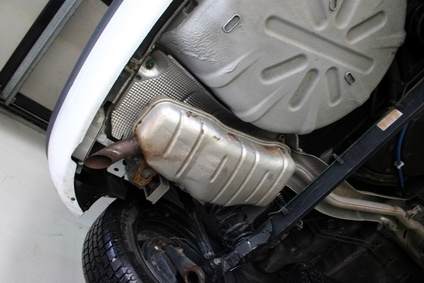
There have always been varying methods to clean catalytic converters that have clogged or even burned internally. Some results have proved satisfactory, while some procedures have been questioned by automotive experts. The process of maintaining a good catalytic converter depends upon preventive maintenance and retarding excessive accumulations as a first priority in the beginning. Likewise, the ways to clean fuel injectors have some different opinions.
Catalytic converters clog up with excessive hydrocarbon build-up on the inside that usually results from overly rich fuel mixtures causing cylinder misfires. The best way to prevent build-up or curtail future build-up requires a complete tune-up that ensures all cylinders have proper hot firing spark with no cylinder misses. Advancing the timing a few degrees and replacing the spark plugs with a "hotter" specification range will induce more heat into the catalytic converter, thus burning away excess, unburned deposits.
Short city sprints in a vehicle, in which the engine has not been allowed to reach higher temperatures, will not raise the catalytic converter heat high enough to burn (clean out) the interior honeycomb converter system. Multiple cold starts and continued idling can load-up a catalytic converter prematurely, especially in cold weather. To keep the catalytic converter clear and hot, the vehicle must be run at highway speeds for extended times and at regular intervals.
You can remove the catalytic converter from the exhaust system and check it internally for excessive carbon build-up and soot. A catalytic converter that rattles when shaken, means particulate matter has filled up the inside of the case. A high pressure wash through both the inlet and outlet pipes of the converter can remove some debris. The converter must be left to dry thoroughly, or be blasted out with a high pressure air hose.
Scientists from the Madrid, Spain based Institute of Catalysis and Petrochemistry discovered that a diluted solution of citric acid can be successful in washing out catalyst build-up without harming the platinum material inside catalytic converters. The process requires an immersion bath of the catalytic converter in the solution for a period of eight hours or more, then a completely drying. It should be noted that this procedure has not been fully implemented as a legitimate or recognized solution for public use.
Fuel additives best serve as a preventive maintenance method rather than a cure-all for seriously plugged injectors. These can best be used early in a vehicle's life, and according to the directions pertaining to the frequency of use. If you consider the use of fuel additives for cleaning, the highest quality product with the best testing results should be used.
A repair facility, that has the equipment, can hook your vehicle up to a pressurized cleaning device designed for fuel injectors. Typically, the gas tank hose must be clamped off, where only cleaning fluid and fuel can enter into the fuel injection rails at high pressure. The process involves the addition of a strong detergent to the fuel in order to break up any varnish or carbon build-up in the lines and the injector heads. The issue with this procedure stems from the fact that the process must use a strong enough cleaner under enough pressure to break down the heaviest deposits, which might not be possible for heavily congested lines and injector heads.